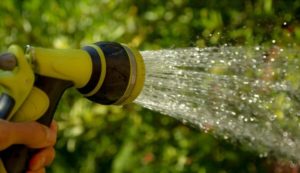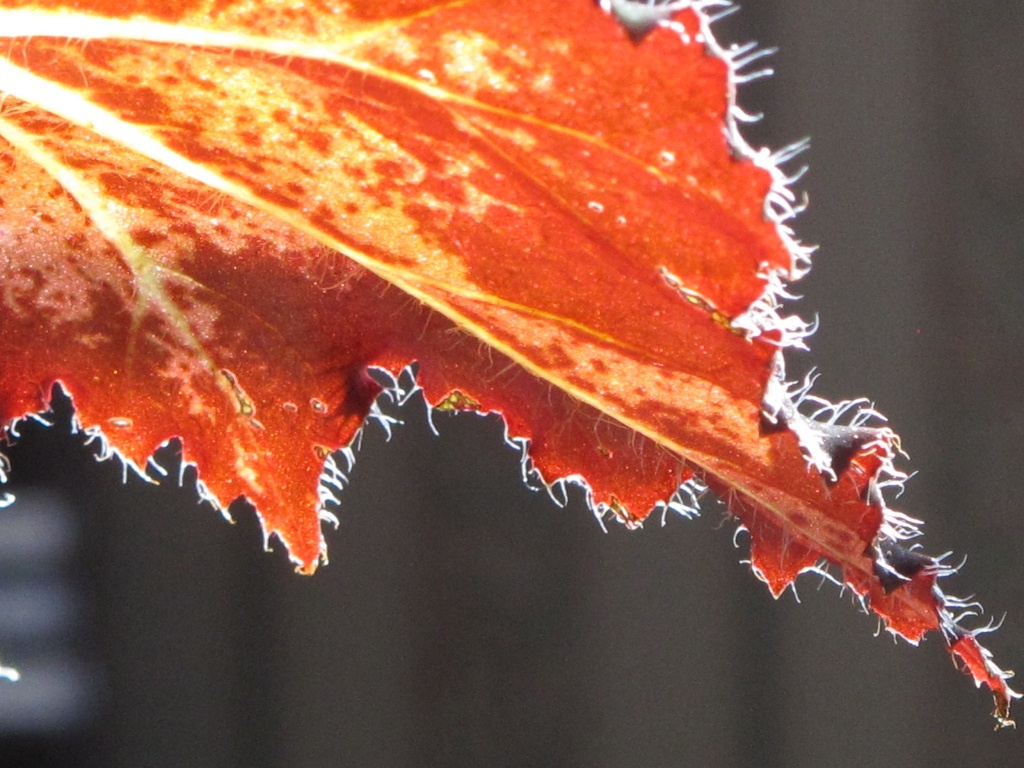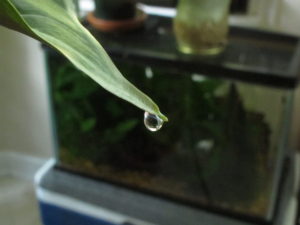Page 2
How Often Should I Water Houseplants?
When purchasing houseplants from the garden center or the farmers’ market, ask for detailed directions for maintenance. Copy the botanical name of the plant, or at least the common name, so you can research its requirements.
Peace lily likes moist soil, but that could cause root rot in a corn plant (Dracaena massangeana). So, even if two plants are native to similar climates, they might not necessarily prosper with the same care. Learning how all the environmental variables work together and plants’ specific requirements will guide you about their need for water.
Resist the temptation to ask, simply, “How many days should I wait to water it?” Instead, find out if that specific plant needs to stay moist because it’s from a tropical rain forest (many ferns, peace lily, Philodendron selloum). Or that it’s native to a sunny, hot, dry climate with gravelly soil and needs to completely dry out before watering again (succulents, lavender).
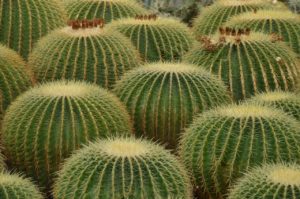
Large cactus plants store water in their stems, rarely needing water in the winter.
For Example
A large spiny cactus (photo, above) in an 8″ pot can go without water for 2 or 3 months in the winter. Other succulents, however, such as Haworthia retusa in a 3″ clay pot, will shrivel up or possibly die after 4 weeks of sun and drought. They’re both succulents, but they’re different succulents. In addition, that same Haworthia in a shallow dish garden with a few other succulents, and gravel on the surface of the soil, might remain moist for 4 weeks. Feeling the soil is the best indicator of its moisture level.
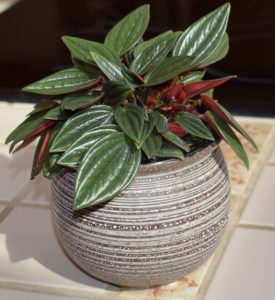
A Peperomia.
Sometimes the plant needs damp soil, not too moist, and prefers to stay potbound. (English ivy, Cryptanthus [a terrestrial bromeliad], Dracaena marginata, Peperomia). Others need cool temperatures to flower, a small pot, and might go dormant for a few months in summer, when it should be kept dry (miniature Cyclamen).
We keep a brown-leaved Rex begonia (photo, below) on the kitchen table where the afternoon sun shines in. It’s still in the original 4″ pot, but the plant has grown to 10″ tall and 16″ wide. It gets watered every 2 or 3 days. If I transplant it now into a 5″ pot, the begonia’s fine, fibrous root system could rot. So I’ll wait until spring, when it will go into a combination planter, and outside to the shady part of the deck. Other plants in the same pot will help dry the soil.
The responsibility of keeping plants alive can seem intimidating to new gardeners. Failures and successes (we’ve all had both) are part of the learning experience, and over time you’ll gain confidence and come to a point where you can rely on instinct. Knowing what to do for your plants will become second nature.
- Rex begonia flower buds.
- Rex begonia leaf.
Should I Fertilize My Houseplants?
Active growth in plants slows down when days shorten, the sun weakens, and temperatures cool. They usually take a rest in winter. But, if your leafy tropicals continue to produce healthy foliage, and are receiving strong light, fertilize them at 1/4 to 1/2 the recommended strength every 4 to 6 weeks. This assumes that the plant wasn’t recently potted into fresh soil, which has some fertilizer in it. Use a soluble all-purpose houseplant fertilizer for a quick response.
Timed-release products, such as Osmocote, can save you the trouble of more frequent liquid applications, but use a low-dose amount at this time of the year. With each watering, the little prills release a small amount of fertilizer to the soil.
Houseplants that grow slowly or not at all in winter should not be fertilized. Those salts will remain unused in the soil and will burn the tender root hairs that the plant needs to absorb water. Succulents, snake plants, ponytail palms, and large tropicals in roomy containers probably won’t need fertilizer until March, when they begin to show signs of new life. Err on the side of underfertilizing rather than overfertilizing, especially for plants in less than ideal light.
If you think you might have given them too strong a solution of fertilizer or fertilized too often, rinse 2 or 3 gallons of clear water through a gallon sized pot to flush out the excess salts.
Signs that houseplants need to be fertilized:
- lower leaves are turning yellow and dropping off
- the plants look sickly
- there’s no new growth
- recent growth is small, pale, and thin
- the plants are very potbound
If your plants haven’t been fertilized in months, give them a 1/2 strength solution of fertilizer. Keep in mind that fertilizing ailing plants can cause a rapid decline…unless lack of nutrients was the problem in the first place.
Brown Tips On Houseplants
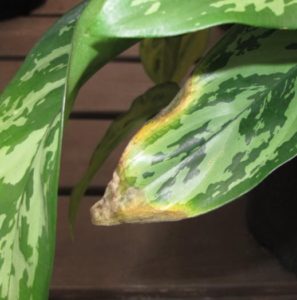
Chinese evergreen, Aglaonema.
Houseplants that have tender foliage and pointed leaf tips, such as peace lilies, palms, spider plants (Chlorophytum), dracaenas, Chinese evergreens (Aglaonema), and Alocasia, often develop brown leaf tips. Even the rugged ponytail palm (Beaucarnea) normally develops a few inches of brown tips on older leaves.
This can be caused by warm, dry air, and by dry soil. It also can be caused by wet soil! The stress of living in low light shows up as thin, weakened leaf tissues. But even well-grown plants often have brown tips on older foliage.
It’s the nature of many of the plants we grow; unless you live in a greenhouse, expect some brown tips on the leaves of your houseplants. Where these tropicals live, in their native habitats, pointed leaves help drain the daily rain off the foliage.
If there’s more benefit to the plant to keep the leaf, since it’s mostly green and photosynthesizing, simply trim off the brown edges. Remove the leaf if it has diminished in size, but try to track down the causes for the brown tips. The following sections describe a few of those causes.
Overwatering
Roots need oxygen for respiration. This process takes place both night and day, and utilizes the products of photosynthesis (sugars) to generate energy for growth. Aeration in the soil affects root function and the plant’s overall growth rate.
A waterlogged medium not only blocks access to oxygen, but also offers conditions that favor the growth of pathogens. Soil-borne diseases rot the roots, often killing the plant. This is why we frequently stress good soil porosity (“air pore space”). Find out if your plant needs consistently moist soil, slightly moist soil, soil that is allowed to dry most of the way through the pot, or soil that must dry completely before watering again.
Avoid overwatering plants, which decreases oxygen content in the soil. Heavily composted (low porosity) soil in a pot that is too large for the plant also contributes to the plant’s demise. When repotting or rejuvenating houseplants, mix pine fines (partially composted bits of pine bark) and/or perlite into heavy potting soil to increase its porosity.
Above all, make sure excess water can drain from the pot. Planting directly into a pretty pot without drainage holes is asking for trouble! Consider double potting the plant—in other words, keeping the plant in its nursery pot and placing it inside a decorative ceramic pot without holes. Just be sure to empty water that collects in the bottom. Use an old turkey baster or sponges for large pots that can’t easily be emptied otherwise.
Underwatering

Bird’s nest fern (Asplenium nidus).
At times, roots can’t supply adequate water to all the foliage, as from underwatering, lack of rain outdoors, or root disturbance. Water plants thoroughly to moisten all the roots. But don’t let the plants sit in a saucer of water for more than 15 or 20 minutes.
The lovely bird’s nest fern (Asplenium nidus, photo, above) has broad fronds, unusual for a fern. Lack of soil moisture and low humidity cause the tender tips or entire edges of the fronds to turn brown.
Overfertilization
Fertilizer manufacturers have developed a wide assortment of products for houseplants, both synthetic and organic. If in doubt about what to use, ask at the garden center or use products with low numbers on the label. Chinese evergreens, for example, prefer lower analysis fertilizer in the ratio of 3-1-2, Nitrogen-Phosphorus-Potassium. They also like some copper in the fertilizer.
You’ll find products formulated for particular groups of indoor plants, such as African violets, orchids, ferns, foliage plants, or flowering plants. Check the dilution rates printed on the label.
After decades of observation, I conclude that we generally fall short on regular applications of fertilizer to maintain healthy growth. Many of my customers have said they never fertilize their plants. If this sounds like the usual practice in your home, try giving your plants some fertilizer a few times year, in spring, early summer, and late summer. You’ll see a huge difference!
Overfertilizing, though, can cause brown tips and actually kill the plant by “burning” the roots. High fertilizer salt concentrations in the soil, relative to the root’s water content, force the root hairs to give up water.
By rotating among a few different fertilizer products over time, your plants will receive all the nutrients required. Use label recommendations for plants growing in conditions that approximate the greenhouse environment. But, for most of our houseplants in winter, it’s better to dilute the fertilizer.
Even in good growing conditions indoors, both old and young leaves can develop browning on the tips.
Disease
Fungal and bacterial diseases can affect Chinese evergreens (Aglaonema), peace lilies, pothos, philodendrons, and others. Brown leaftips or margins, spotting, curling leaves, and root rot are symptoms of disease. Keep the foliage dry, and remove leaves with significant yellow or brown markings. Lower the stress by maintaining temperatures around 70° for tropical plants. Use lukewarm water, especially in winter.
Diseases can affect roots, stems, and leaves in susceptible houseplants if spores are present and if the plant is subjected to stressful conditions. Look for brown spots on leaves, with or without yellow halos, rotting tissues on stems, and poor growth and wilt due to root rot. Remedies stocked by garden centers usually work well for plants in early stages of the infection, but improve cultural conditions as well.
Guttation
A plant in moist soil can drip water during the nighttime hours from the tip of the leaf, or along the leaf margins, from special pores called hydathodes. We don’t often see this process happening indoors, although now and then you might spot a little pool water on the table or the floor. This is called guttation; the plant is relieving some of the root-driven water pressure from within plant tissues.
Each time these drops evaporate, a small amount of dissolved mineral salts is left behind. As those salts increase in concentration, they can damage the tissues on the tips or edges of the leaves, causing them to turn brown. Following the natural outline of the leaf, simply cut off the brown parts, or ignore them. Let the plants dry out a bit more before watering, but not to the point of wilt.
Plants grow luxuriantly outdoors in the rain, higher humidity, and brighter light of a summer patio. Rain washes away dust, grime, some insects and spider mites, and those mineral salts. With regular applications of fertilizer, new foliage looks beautiful and grows quickly. That’s a good time to remove old foliage, but, of course, you’ll have to wait for warm weather to place the plants outside.
Fluorine
Present in municipal water supplies, fluorine is another cause of browning leaf tips. Fluorine also can cause yellow mottling of leaves in sensitive species. Water softeners add minerals that can cause problems with foliage.
If you can, collect rainwater for your houseplants, but let it warm up to room temperature before using. One benefit of using rainwater is its nitrogen content. As rain falls through the air, it picks up some of the nitrogen, which is the most abundant element in the atmosphere. Nitrogen encourages foliage to grow and gives it a healthy green color. And, of course, there’s no fluorine or chlorine in rainwater.
Yellow Leaves

The problem Ficus.
This morning, I noticed a large number of yellow leaves on a 4′ tall Ficus tree kept in the sunny bay window. This particular plant is an uncommon cultivar, species unknown, with graceful horizontal branches and a smaller habit than the weeping fig (Ficus benjamina). If I don’t water the potbound plants often enough, some of the leaves will turn yellow and eventually fall off.
So I checked all the plants in that window. Picking up the lightweight plant signaled the need for a thorough watering. We’ve had a cloudy, rainy winter, and the plants haven’t required much water. Then we had a couple of sunny days, and the soil dried out more than the plant prefers. It happens! A few days later, one fourth of the plant turned yellow. This plant doesn’t wilt before it turns yellow.
Yellow leaves can indicate any one or a combination of causes:
- Dry soil.
- Wet soil.
- Low light.
- Too much light, causing sun scald.
- Hot dry air.
- Cold roots.
- Lack of nitrogen or other nutrients, including sulfur, magnesium, or iron.
- Overfertilizing.
- Problems with soil pH or compaction.
- Old age of those particular leaves.
- Insect or spider mite infestations.
- Root disturbance/pruning.
Well, that narrows it down! Sometimes it does require some sleuthing to find the cause. Although a plant with a large number of yellow leaves is a concern, one or two showing up now and then is normal.
Yellow leaves on the problem Ficus will continue to appear. In a few days, the plant will stabilize and stop turning yellow. This plant needed heavy root-pruning in the fall, before bringing it indoors for the winter, because its roots had wandered into the pots of its neighbors! A wet summer encouraged out-of-control growth on some of the plants.
Most of our plants spend the summer outdoors, so I’ll have to watch that one in the future. It reminds me of those banyan trees (yes, another Ficus, in the photo, above) whose aerial roots swallow up stone monuments and abandoned ancient villages. The plant was simply sacrificing a few leaves so it could distribute remaining resources among fewer leaves.
My Houseplants Are Dropping Leaves
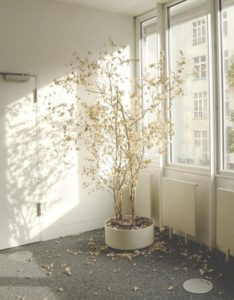
Yellow leaves on the problem Ficus weren’t caused by lack of fertility; the rest of the leaves are dark green. The suddenness of the event, the large number of affected leaves, and the tell-tale light weight of the pot indicated lack of water as the cause. My fault! The plant is sacrificing some leaves to ease the demand on the root system to provide water to the rest of the plant. It’s a survival tactic.
A plant that remains bone dry or sopping wet for a period of time will deteriorate. Symptoms of distress (wilt, yellow or brown leaves, leaf drop) occur in response to adverse conditions, and those conditions are different for each plant.
For example, most succulents should run quite dry in the winter, especially during overcast weather. If they’re kept too moist, the leaves usually don’t wilt, but the roots will rot instead. A peace lily (Spathiphyllum) objects when the soil dries out and responds quickly by wilting. That’s why it’s important to know detailed growing conditions for each kind of plant.
The plant in the photograph above illustrates long-term neglect. It looks as if the apartment had been vacated, and the tree left behind. A large amount of foliage, a small pot, and no water spelled doom for this plant. It has no chance of recovery. Probably. But there could be life (dormant buds) in the stem. If you have one like it, cut the plant down to 2′ tall above the soil, and water it. Give it a month to show something green, and if it does, pat yourself on the back. Well done!
Headings:
Page 1: What Is Wrong With My Houseplants?, My Peace Lily Is Wilting, How Often Should I Water My Peace Lily? (The Environmental Variables, How Can I Tell When To Water?, Upon Careful Examination)
Page 2: How Often Should I Water Houseplants?, Should I Fertilize My Houseplants?, Brown Tips On Houseplants (Overwatering, Underwatering, Overfertilization, Disease, Guttation, Fluorine), Yellow Leaves, and My Houseplants Are Dropping Leaves
Page 3: Succulents (Porous Pots, Repotting and Refreshing), Ferns (Raise the Humidity), Pothos and Philodendron, Snake Plant (What is CAM?), English Ivy (Spider Mites), Will They Flower Some More?, and Before You Know It
